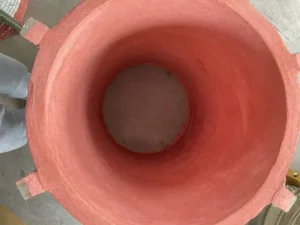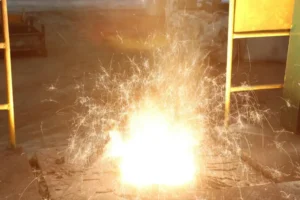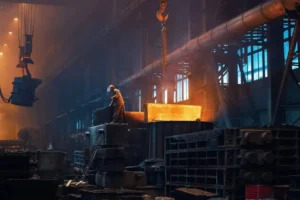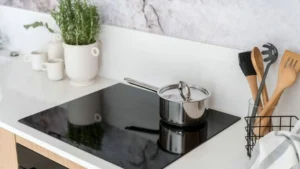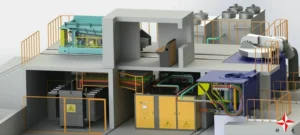Teknologi pemanasan induksi multi frekuensi adalah metode canggih yang menggunakan kombinasi frekuensi arus induksi yang berbeda untuk mencapai kurva pemanasan yang lebih tepat dan kompleks, secara efektif memproses berbagai bahan.
This technology overcomes the limitations of traditional single-frequency induction heating, menunjukkan potensi besar dalam pemrosesan material dan perlakuan panas.
Cara Kerja Pemanasan Induksi Multi Frekuensi
Inti dari pemanasan induksi adalah menghasilkan arus eddy dalam bahan konduktif menggunakan induksi elektromagnetik. Arus eddy ini, pada gilirannya, menghasilkan pemanasan Joule karena ketahanan material. Kedalaman pemanasan (atau “kedalaman kulit”) berkaitan erat dengan frekuensi saat ini:
- Frekuensi Tinggi: Menghasilkan kedalaman kulit yang dangkal, memusatkan panas pada permukaan material. Ini cocok untuk pengerasan permukaan, mematri, memanaskan benda kerja kecil, dan aplikasi yang membutuhkan pemanasan permukaan yang cepat.
- Frekuensi Rendah: Mengarah ke kedalaman kulit yang lebih dalam, memungkinkan panas menembus lebih jauh ke dalam material. Ini ideal untuk pemanasan menyeluruh, pemanasan benda kerja yang besar, perlakuan panas yang dalam, dan mencair.
Sistem pemanas induksi multi frekuensi biasanya mencakup beberapa unit daya independen, masing-masing mampu mengeluarkan arus pada frekuensi yang berbeda. Dengan mengontrol frekuensi keluaran secara tepat, kekuatan, dan durasi unit daya ini, Anda bisa mencapainya:
- Pemanasan Berlapis: Misalnya, Anda dapat memanaskan benda kerja secara seragam dengan frekuensi rendah, kemudian dengan cepat memanaskan atau mengeraskan permukaannya dengan frekuensi tinggi.
- Pemanasan Gradien: Buat distribusi suhu berbeda dalam berbagai area benda kerja yang sama, seperti gradien suhu sepanjang batang panjang.
- Kontrol Suhu Yang Tepat: Untuk benda kerja dengan geometri kompleks atau material yang sensitif terhadap suhu, you can dynamically adjust the frequency combination based on the specific heating needs of different regions, menghasilkan kontrol suhu yang lebih akurat.
Mencapai Kurva Pemanasan yang Lebih Kompleks
Kurva pemanasan kompleks mengacu pada perubahan non-linear pada suhu benda kerja dari waktu ke waktu atau posisi selama proses pemanasan. Pemanasan induksi multi frekuensi mencapai hal ini:
- Peralihan Frekuensi: Sistem dapat secara otomatis mengganti atau menggabungkan frekuensi arus yang berbeda selama berbagai tahap proses pemanasan. Contohnya, frekuensi yang lebih rendah mungkin digunakan untuk pemanasan awal yang cepat, beralih ke frekuensi yang lebih tinggi untuk memanaskan atau menahan permukaan setelah suhu tertentu tercapai.
- Kontrol Tenaga dan Waktu yang Terkoordinasi: Dengan menggabungkan daya keluaran dan durasi frekuensi yang berbeda, Anda dapat mengontrol masukan panas dengan tepat, sehingga menelusuri kurva suhu-waktu yang diinginkan.
- Desain Multi-Koil: Untuk benda kerja dengan bentuk yang rumit, Anda dapat merancang beberapa kumparan induksi independen, masing-masing digerakkan oleh arus dengan frekuensi atau daya berbeda. Hal ini memungkinkan kurva pemanasan yang disesuaikan di berbagai wilayah benda kerja.
- Sistem Umpan Balik Loop Tertutup: Integrating sensors like infrared thermometers allows for real-time monitoring of the workpiece temperature. Sebuah PLC (Pengontrol logika yang dapat diprogram) atau algoritme tingkat lanjut kemudian dapat menyesuaikan frekuensi dan daya secara dinamis untuk memastikan kurva pemanasan sesuai dengan target yang telah ditetapkan.
Memproses Bahan Berbeda
Bahan yang berbeda memiliki konduktivitas listrik yang berbeda-beda, permeabilitas magnetik, dan sifat termofisika, semuanya memengaruhi perilaku mereka selama pemanasan induksi. Pemanasan induksi multi frekuensi lebih siap untuk memproses beragam bahan karena kemampuannya:
- Beradaptasi dengan Sifat Elektromagnetik Material:
- Konduktivitas Listrik: Bahan dengan konduktivitas listrik yang tinggi (seperti tembaga, aluminium) membutuhkan frekuensi yang lebih tinggi untuk memanaskan permukaannya secara efektif. Untuk bahan dengan konduktivitas lebih rendah, frekuensi yang lebih rendah dapat menembus lebih dalam. Sistem multi-frekuensi dapat memilih rentang frekuensi yang paling sesuai berdasarkan konduktivitas material.
- Permeabilitas Magnetik: Bahan feromagnetik (seperti baja di bawah titik Curie-nya) mempunyai permeabilitas magnetik yang tinggi, yang menghasilkan kerugian histeresis tambahan selama pemanasan induksi, mengarah pada efisiensi yang lebih tinggi. Ketika suhu melebihi titik Curie, bahan tersebut kehilangan daya magnetnya, mempengaruhi efisiensi pemanasan. Sistem multi-frekuensi dapat menyesuaikan frekuensi dan daya untuk mengakomodasi perubahan sifat magnetik material pada suhu yang berbeda.
- Optimalkan Efisiensi Pemanasan: Untuk bahan tertentu, terdapat frekuensi pemanasan optimal yang memaksimalkan efisiensi konversi energi. Sistem multi-frekuensi memungkinkan operator memilih atau menggabungkan frekuensi terbaik berdasarkan karakteristik material, mengoptimalkan efisiensi pemanasan dan mengurangi konsumsi energi.
- Memproses Bahan Komposit: Untuk material komposit yang terbuat dari berbagai komponen konduktif dan non-konduktif, pemanasan induksi multi frekuensi dapat dirancang untuk memanaskan secara selektif hanya bagian konduktif, atau untuk mencapai pemanasan keseluruhan yang seragam dengan menyesuaikan frekuensi dan daya.
Skenario Aplikasi
Teknologi pemanas induksi multi-frekuensi memainkan peran penting dalam banyak aplikasi yang kompleks dan menuntut:
- Perlakuan Panas pada Bagian Kompleks: Misalnya, poros engkol atau roda gigi otomotif yang memerlukan kedalaman pengerasan atau temper berbeda di berbagai bagian untuk mencapai sifat mekanik yang optimal.
- Modifikasi Permukaan dan Pemanasan Terintegrasi: Dalam beberapa proses, benda kerja mungkin perlu dipanaskan, diikuti dengan pengerasan permukaan frekuensi tinggi yang cepat untuk menciptakan lapisan tahan aus.
- Menggabungkan Bahan Berbeda: Saat mematri atau mengelas logam berbeda dengan konduktivitas listrik dan titik leleh yang berbeda-beda, pemanasan induksi multi frekuensi menawarkan solusi pemanasan yang lebih fleksibel.
- Pemanasan Bahan Non-Ferromagnetik: Meskipun pemanasan induksi pada bahan non-feromagnetik seperti tembaga dan aluminium dapat menjadi tantangan, sistem multi-frekuensi dapat secara efektif memanaskan material ini melalui kombinasi daya tinggi dan frekuensi tertentu.
- Kontrol Suhu Presisi untuk R&D: Dalam penelitian ilmu material, sampel sering kali memerlukan siklus suhu yang tepat atau pemanasan gradien. Pemanasan induksi multi frekuensi memberikan kemampuan untuk mencapai profil pemanasan kompleks ini.
Singkatnya, teknologi pemanas induksi multi frekuensi menawarkan fleksibilitas lebih besar dan kontrol lebih baik, memungkinkan pemanasan induksi beradaptasi dengan beragam aplikasi industri dan jenis material. Hal ini membawa keuntungan signifikan bagi manufaktur modern dan pemrosesan material.


